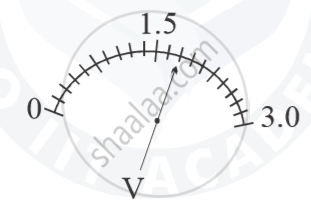Advertisements
Advertisements
प्रश्न
Consider the sacle of voltmeter shown in the diagram and answer the following questions :

(a) What is the least count of the voltmeter?
(b) What is the reading shown by the voltmeter ?
(c) If the voltmeter is connected across a resistor of 20 `Omega` how much current is flowing through the resistor?
उत्तर
(a) Least count = `3/20 = 0.15V`
(b) `(1.5 + 0.15 + 0.15)V = 1.8 V`
(c) R = 20 `Omega`
`V = 1.8 V`
`therefore I = ?`
By ohm’s law
`V = IR`
`1.8/20 = I therefore I = 0.09 A`
APPEARS IN
संबंधित प्रश्न
What is an Ohmic resistor?
The graph between V and I for a conductor is a straight line passing through the origin.
Which law is illustrated by such a graph?
An electric bulb draws 1.2 A current at 6.0 V. Find the resistance of filament of bulb while glowing.
State and define Ohm’s law.
Obtain the macroscopic form of Ohm’s law from its microscopic form and discuss its limitation.
Explain the equivalent resistance of a parallel resistor network.
Assertion: The statement of Ohm’s law is K = IR.
Reason: V = IR is the equation which defines resistance.
Let the resistance of an electrical device remain constant, while the potential difference across its two ends decreases to one fourth of its initial value. What change will occur in the current through it? State the law which helps us in solving the above stated question.
A current of 3.2 mA flows through a conductor. If charge on an electron is - 1.6 × 10-19 coulomb, find the number of electrons that will pass each second through the cross section of that conductor.
